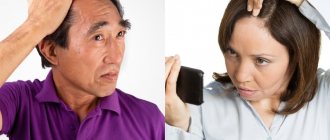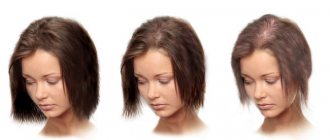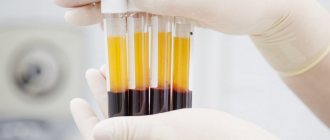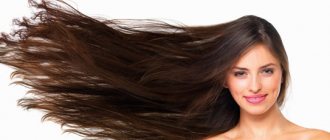Losing a hundred hairs every day is normal. Save your hair!
Every day we lose about a hundred hairs and this is considered normal. To get an idea of how much hair you are losing, select a small section and gently pull.
If there are 2 hairs or less on your hand, then you don’t need to panic, but if there are more, then it’s time to do something.
Probably few people are indifferent to hair loss, especially women. But what to do if they just started to fall out catastrophically. If this is not pathological and genetic baldness or hair loss due to treatment, then you need to look for the cause. Try it yourself first.
Hair growth cycle
So how much hair does a person lose per day? To answer this question, let's define the phases of the life cycle.
Hair grows daily, with each hair lasting an average of 4 years. The hair follicle prepares a new one to replace the lost hair, compensating for the loss.
The following phases of hair life are distinguished:
- Origin. Over the course of 2–4 years, a hair follicle with a new hair is formed. At this stage, from 60 to 90% of all hair can remain.
- Transition period. The hair no longer grows, and the follicle itself moves closer to the surface of the skin. As a rule, 2% of all curls are in this state.
- Natural loss (telogen). Degeneration stage: old hair falls off on its own or due to mechanical impact on it. In its place, a new one is already born in the follicle.
Important point! If hair falls out during the telogen stage, you should not be alarmed, because this is a completely natural process. The hair follicle will soon throw out a new hair, there is no threat to thick hair.
Stages of alopecia
Acute forms and cicatricial type of baldness do not have distinct stages. In all other cases, the following are distinguished: 1. First signs. First, the curls become thinner and noticeably thinner. Visually, it is impossible to notice any violations of the cover, but the lack of overall volume and mass is obvious. 2. Noticeable manifestations. Several months or even years pass from the first stage to the second. However, the result is the same - bald patches and areas without strands form on the head, and the remaining hairs on the temples and back of the head become thin and lifeless, losing their natural shine and beauty.
What is the norm
Many men and women strive to maintain thick hair and prevent alopecia (excessive hair loss, leading to the formation of receding hairlines and total baldness). Therefore, it is important for them to know the rate of hair loss per day.
There are no specific indicators, because the process of “reincarnation” of hairs directly depends on the individual characteristics of the organism. As a rule, hair begins to grow more in winter and autumn.
So what is the normal rate of hair loss per day for women and men? It is believed that from 80 to 100 hairs can be eliminated naturally. In winter and autumn, this figure may increase - 120–150 units.
95% of the fair half of humanity have telogen effluvium. Excessive hair loss is associated with hormonal imbalances during pregnancy and after childbirth, with severe stressful situations or taking contraceptives.
To determine whether your hair loss is normal or pathological, collect your hair the day before using a comb and after taking a shower. Don’t be lazy to count and examine them. If they fall out more than the specified norm or you find a dark bag at the ends of the roots, you should immediately take measures to save the curls.
It is important to know! Washing your hair infrequently can leave a significant clump of hair in the bathtub, sink, or palm of your hand. These are just those fallen hairs that you couldn’t comb out with a comb. If after washing for a week you do not notice a significant reduction in hair, then you do not have alopecia, but natural hair loss.
Oddly enough, the number of hairs on the head directly depends on their color. Scientists carried out calculations and determined the average indicators for owners of different hair shades:
- blondes have about 140 thousand hairs (but fair-haired beauties should not delude themselves, because they have thin ones);
- brown-haired women take second place - 109 thousand hairs;
- brunettes have 102 thousand hairs on their heads;
- Red-haired beasts have only 88 thousand hairs, but they have the densest and most durable hairs.
The normal loss rate per day is 0.1%. Therefore, the indicator corresponding to your hair type must be multiplied by 0.001.
Many people ask the question, “Should hair fall out every day?” They should, because this is a completely natural process of hair renewal. The main thing is that their total number does not exceed the norm, and that bald patches do not form on the skin.
To correctly count the number of hairs that have left the follicle, follow our recommendations:
- Do not wash your hair for three days.
- In the morning, count the number of hairs on your pajamas and pillow.
- Wash your hair by closing the drain. Count the number of lost hairs.
- Dry your hair naturally (without a hair dryer). Comb them with a comb and count the loss again.
- In the evening, comb and count again.
- Add up the number of hairs lost.
There is another simple way to find out how much hair you are losing. Just don't wash your curls for a week, and then run your hand from roots to ends before the procedure. If there are no more than 5 hairs left in your palm, then there is absolutely no need to worry.
A lot of hair is lost when using conditioner while washing. The fact is that it smoothes them out, covering the scales. When washed with regular shampoo, the scales, on the contrary, diverge, therefore, some hairs cling to each other and are not washed off into the sink.
If you notice receding hairline and thickening of the parting line, contact a specialized specialist - a trichologist. He will prescribe a trichogram and a biochemical blood test to check for vitamin deficiencies and infections. With the problem of baldness, you can contact a dermatologist or endocrinologist.
Complete blood count and ferritin
A general detailed blood test is performed to determine the level of hemoglobin in the blood, to exclude anemia, infectious and fungal diseases. Thus, iron deficiency anemia is one of the most common causes of hair loss in women. With a lack of iron, the nutrition and oxygen supply of all organs and systems is disrupted, so hair becomes brittle and unruly and begins to fall out.
Iron deficiency anemia is a clinical and hematological symptom complex in which the formation of hemoglobin is disrupted as a result of iron deficiency in the blood serum and bone marrow, and trophic disorders develop in organs and tissues.
Dermatological signs of iron deficiency:
- Hair: becomes thinner, becomes dry, begins to fall out more and lose pigmentation.
- Nails: become thinner, brittle, and have cross-striations.
- Skin: dry and flaky.
Iron deficiency anemia in most cases causes baldness and acne on the scalp.
Iron is part of hemoglobin, which carries oxygen. If the body does not receive enough iron, hemoglobin deficiency is possible. The lack of this element manifests itself against the background of poor nutrition and problems with the absorption of nutrients. In addition, bleeding is a common cause of anemia. Even minor but chronic blood loss can lead to iron deficiency. Thus, women experiencing excessive physiological blood loss often suffer from mild anemia.
In addition to changes in basic biochemical blood markers, ferritin levels can also indicate iron deficiency. Ferritin is a major participant in iron metabolism and an iron donor for cells that are deficient in it. In addition, it responds to inflammatory processes.
Loss or cut
It is important to correctly distinguish the causes of hair loss: this can happen naturally or due to split ends and burning of the curls with a curling iron or hairdryer. To do this, you need to look at the hair itself.
Important! When you experience hair loss due to hair renewal on one side, you will notice a white thickening called a bulb. If the growth is dark in color, then you need to urgently go to the doctor, otherwise you may lose the follicle.
Looking at a hair that has been lost due to mechanical damage, you will see the same thickness on both sides. In this case, you need to minimize heat treatment of your hair and begin to actively nourish your curls with masks, oils and vitamins.
You should be alarmed if your hair does not fall out or grow at all. This means that they are not updated, and soon you risk losing your beautiful hair. Be sure to consult a trichologist.
If you have thin and split hair, start taking proper care of it:
- trim the ends on time;
- minimize heat treatment;
- moisturize your curls with aloe or lemon juice;
- be sure to use conditioner;
- Make a gelatin mask once a week.
What is included in the screening
Program 190 “Healthy Hair” includes the following studies:
- complete blood count
- thyroid stimulating hormone (TSH)
- total testosterone;
- ferritin;
- vitamin D (25-hydroxycalciferol).
Deviation of any indicator from reference values requires consultation with a doctor.
The results of the program will help you find the cause of hair loss and prescribe adequate treatment. Stopping the process of baldness is not so difficult - the main thing is to identify the biochemical markers of incipient alopecia in time. The complex will help you conduct an initial diagnosis of some possible causes of the “unhealthy” appearance of hair, skin and nails. It is recommended for anyone who has noticed that their hair has begun to fall out more than usual, their nails have become brittle, and skin problems have arisen. Thanks to this program, you will see whether the disorders are associated with hormonal changes, thyroid diseases, hidden infectious and inflammatory processes, lack of iron or vitamins, diabetes and other pathological conditions.
Let's take a closer look at these biochemical markers.
Factors leading to losses
Factors that contribute to excessive hair loss include:
- Weak immunity, which provokes hair loss in winter and autumn. To eliminate the problem, you need to drink a vitamin complex to generally strengthen the body.
- Anemia caused by iron deficiency. It is necessary to donate blood for hemoglobin and, if a deficiency is detected, introduce certain foods into the diet: nuts, beef, pomegranate, apples, liver.
- Pregnancy and lactation. For many breastfeeding mothers and women in an interesting situation, hair can simply come out in clumps. This is due to the fact that all vitamins and nutrients are aimed at the baby’s health. Taking medications and vitamin complexes usually does not eliminate the problem. Therefore, it is recommended to simply wait out this period - after some time, your health will improve, and your hair will regain its former lushness and thickness.
- Taking medications, in particular antibiotics, birth control pills. antidepressants and diuretics.
- Diseases of the skin of the scalp (dermatitis, seborrhea, ringworm, psoriasis and others), most of which are associated with fungal diseases. Only special treatment prescribed by a dermatologist will help eliminate the disease.
- Increased background radiation or water contaminated with chemicals. Poor ecology can harm your hair.
- Mechanical effect on curls. Combing with a metal comb, frequent use of a straightening iron and hair dryer, as well as the use of chemical dyes have a detrimental effect on the hair structure, leading to hair loss even at the growth stage. It is necessary to minimize the negative impact of these factors.
- Temperature changes or regular coffee consumption. These reasons provoke poor blood supply and lack of oxygen. Consequently, the bulbs do not receive enough nutrients, which affects the thickness of the hair.
- An unbalanced diet, frequent unhealthy diets and poor fluid intake lead to hair problems. You need to drink at least 1.5 liters of water per day.
If you want to have attractive thick hair, follow these recommendations:
- eat properly and balanced;
- do not use shampoos with lauryl sulfate or other parabens;
- do not dye your hair or at least use ammonia-free dyes;
- regularly massage the scalp several times a day using a massage comb or a whisk-like device;
- do not comb wet hair;
- minimize the use of stylers and cosmetics to fix hairstyles;
- stop being nervous, adjust your sleep and rest routine;
- In winter weather and in the summer heat, wear a hat.
Burdock oil has proven itself to be beneficial for improving the condition of hair and giving it strength. At least once a week before washing your hair, rub it into the skin, slightly heating it in a water bath. Leave the product to absorb into the dermis for about 30 minutes. Rinse with shampoo and plenty of water.
Every woman, in order to control the condition of her curls, should know how much hair falls out when washing her hair and combing it naturally per day. By comparing the indicator with the norm, you can either calm down in case of a positive result, or make an appointment with a trichologist to identify and eliminate the root cause of the negative manifestation. Remember: the beauty and thickness of your curls directly depends on your actions and proper care.










